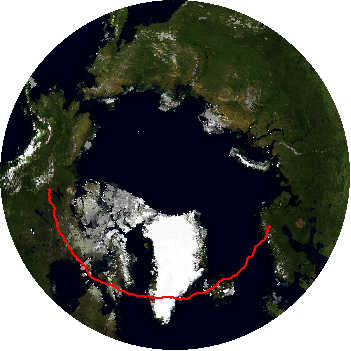News Archive
-
December, 29 2016
BACCUS completed his mission in Antarctica
McMurdo Station, Antarctica.- It looks like a perfectly calculated maneuver, or one of those "manual" cases that are often used to illustrate how a given process should occur, in a complete and perfect way: just a couple of hours after completing both the first month of flight and its Third anticyclonic turn on the Antarctic ice, the balloon that carried the experiment BACCUS, has finished its journey. And merely 50 nautical miles from it's launch site! ...
BACCUS
Terminated flight after
30 days, 2 hours y 1 minute

I do not know the specific operational details, but either by a signal transmitted through NASA's TDRSS satellite network from the control center of the Columbia Scientific Balloon Facility (CSBF) in Palestine, Texas, or perhaps using the Line-Of-Sight (LOS) system operated from the same McMurdo Station, the balloon was separated from its payload around 20:15 utc on December 28, 2016.
Total flight time was 30 days, 2 hours and 1 minute.
The remarkable fact is that thanks to the casual broadening of the route followed by the balloon during its third turn, CSBF had the chance to land the payload of mission 674N, just 50 nautical miles east of McMurdo. In terms of the Antarctic distances and the complexity of the task of rescue an experiment of this type in the white continent, it's like they made BACCUS land in the base's backyard.

At the time of writing these lines, still we have no information on the condition of the gondola at the landing site, but I think it will be only a matter of hours before NASA publishes something about it. We'll see.
In case you have not read my previous post, BACCUS is the acronym for Boron And Carbon Cosmic rays in the Upper Stratosphere, an instrument aimed to investigate the source, propagation and acceleration mechanism of high-energy cosmic-ray nuclei coming from the space. It was developed by the University of Maryland along with the collaboration of the Pensylvania State University, the Ohio State University and NASA Goddard Space Flight Center from USA, Ewha Woman's University, KAIST and KyungPook National University from Korea, the Laboratoire de Physique Subatomique et de Cosmologie, Grenoble and the Centre d'Etude Spatiale des Rayonnements of France and finally the Universidad Nacional Autónoma de México.
Returning to the campaign, in the last days also have finished their mission the two small balloons launched as support of the experiment ANITA IV. Both missions, which had a duration of 13 and 6 days, carried a wave-emitting device that imitates neutrino signals at regular intervals and which were used to perform a sort of "in-flight calibration" while accompanying the silent journey of ANITA in Its second turn to the south pole. For a matter of logistics and costs these small devices are not recoverable.
Thus, as I'm finishing this entry, there are only two balloons circling the Antarctic stratosphere: the one carrying the aforementioned ANITA IV mission, which has been in flight for 27 days and has already begun its third turn to the continent, and the other carrying the STO-2 telescope which is about to complete his second round around the pole after 21 days aloft.
-
Share this on social media


